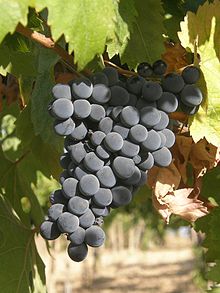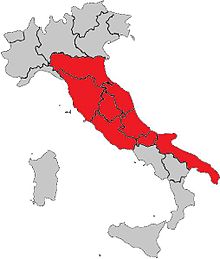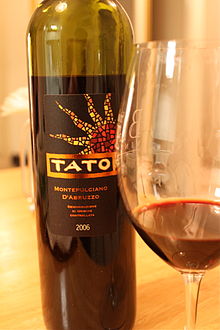- Montepulciano (grape)
-
Montepulciano is a red Italian wine grape variety that is most noted for being the primary grape behind the Denominazione di Origine Controllata e Garantita (DOCG) wine Montepulciano d'Abruzzo Colline Teramane (as well its larger DOC outside of Colline Teramane) and the Denominazione di origine controllata (DOC) wines of Rosso Conero and Rosso Piceno.
It should not be confused with the similarly named Tuscan wine Vino Nobile di Montepulciano, which is made from predominantly Sangiovese and is named for the village it is produced in, rather than for containing any Montepulciano grapes in the blend.
The grape is widely planted throughout central and southern Italy, most notably in Abruzzi, Latium, Marche, Molise, Umbria and Apulia, and is a permitted variety in DOC wines produced in 20 of Italy's 95 provinces. Montepulciano is rarely found in northern Italy because the grape has a tendency to ripen late and can be excessively "green" if harvested too early.
When fully ripened, Montepulciano can produce deeply colored wines, with moderate acidity and noticeable extract and alcohol levels.[1]
Contents
Origins and confusion with other Montepulciano wines
According to wine expert Jancis Robinson, Montepulciano likely originated in Tuscany and may be related to Sangiovese of which the two grapes are often confused for each other. Despite this possible origin, the Montepulciano grape still does not seem to have any tangible connection to the Montepulciano village and the Vino Nobile di Montepulciano beyond what Robinson describes as "linguistics".[2][3] Furthermore, despite being widely planted throughout central Italy, the Montepulciano grape is not even grown in the vineyards around the village of Montepulciano.[4][5]
Wine regions
After Sangiovese, Montepulciano is Italy's second most widely dispersed indigenous grape variety. It is a recommend planting in 20 of Italy's 95 provinces and is a permitted or required grape in the red wines of DOCs in Apulia, Molise, Latium, Umbria, Marche, Emilia-Romagna, Abruzzi and Tuscany. Among the DOCs that are most noted for Montepulciano are Montepulciano d'Abruzzo in Abruzzi, Rosso Conero and Rosso Piceno in Marche. Though it is a secondary variety to Uva di Troia in the Castel Del Monte DOC, wine expert Jancis Robinson the character that Montepulciano contributes to the blend as perhaps "its finest incarnation".[2]
DOCs and DOCGs
The following is a list of DOCs and DOCGs that include Montepulciano as a permitted grape variety, along with other grapes that may be included in the blend under varying percentages that are regulated under the DOC/G label. The wines of which Montepulciano must account for a majority of the blend are in bold.[6]
- Alezio DOC – (Apulia) can be blended with Negroamaro, Sangiovese and Malvasia
- Biferno DOC – (Molise) Must be 60–70% of the wine. Can be blended with Trebbiano Toscano (in rosé and red wines) and Aglianico
- Brindisi DOC – (Apulia) can be blended with Negroamaro, Sangiovese and Malvasia
- Cacc'e mmitte di Lucera DOC – (Apulia) can be blended with Sumarello, Sangiovese, Malvasia, Trebbiano and Bombino Bianco
- Castel Del Monte DOC – (Apulia) can be blended with Uva di Troia, Sangiovese, Aglianico and Pinot noir
- Castelli Romani DOC – (Latium) can be blended with Cesanese, Merlot, Sangiovese and Nero Buono
- Cerveteri DOC – (Latium) can be blended with Sangiovese, Cesanese, Canaiolo Nero, Carignan and Barbera
- Cesanese di Olevano Romano DOC – (Latium) can be blended with Cesanese, Sangiovese, Barbera, Trebbiano and Bambino Bianco
- Colli Amerini DOC – (Umbria) can be blended with Sangiovese, Ciliegiolo, Canaiolo, Merlot and Barbera
- Colli Etruschi Viterbesi DOC – (Latium) can be blended with Sangiovese
- Colli Maceratesi DOC – (Marche) can be blended with Sangiovese, Cabernet Sauvignon, Cabernet Franc, Ciliegiolo, Lacrima, Merlot and Vernaccia Nera
- Colli Martani DOC – (Umbria) can be blended with Sangiovese, Canaiolo, Ciliegiolo, Barbera, Merlot, Trebbiano, Grechetto, Malvasia, Garganega and Verdicchio
- Colli Perugini DOC – (Umbria) can be blended with Sangiovese, Ciligiolo, Barbera and Merlot
- Colli Pesaresi DOC – (Marche) can be blended with Sangiovese and Ciligiolo
- Colli di Rimini DOC – (Emilia-Romagna) can be blended with Sangiovese, Cabernet Sauvignon, Merlot, Barbera, Terrano and Ancellotta
- Collo della Romagna Centrale DOC – (Emilia-Romagna) can be blended with Cabernet Sauvignon, Sangiovese, Barbera and Merlot
- Colli della Sabina DOC – (Latium) can be blended with Sangiovese
- Controguerra DOC – (Abruzzi) At least 60% of the blend. Can be blended with Merlot, Cabernet Sauvignon and Cabernet Franc
- Copertino DOC – (Abruzzi) can be blended with Negroamaro, Malvasia and Sangiovese
- Cori DOC – (Latium) can be blended with Nero Buono and Bonvino Nero
- Esino DOC – (Marche) Along with Sangiovese must be at least 60% of the blend with local varieties filling out the rest
- Gioia del Colle DOC – (Apulia) can be blended with Primitivo, Sangiovese, Negroamara and Malvasia
- Lacrima di Morro d'Alba DOC – (Marche) can be blended with Lacrima and Verdicchio
- Leverano DOC – (Apulia) can be blended with Negroamaro, Malvasia and Sangiovese
- Lizzano DOC – (Apulia) can be blended with Negroamaro, Sangiovese, Bombino Nero, Pinot noir and Malvasia
- Montepulciano d'Abruzzo DOC – (Abruzzi) at 85% of the wine. Can be blended with Sangiovese
- Montepulciano d'Abruzzo Colline Teramane DOCG – (Abruzzi) at least 85% of the wine. Can be blended with Sangiovese
- Nardo DOC – (Apulia) can be blended with Negro Amaro and Malvasia
- Offida DOC – (Marche) at least 50% of the wine. Can be blended with Cabernet Sauvignon
- Orta Nova DOC – (Apulia) can be blended with Uva di Troia, Lambrusco Maestri and Trebbiano.
- Parrina DOC – (Tuscany) can be blended with Sangiovese, Canaiolo and Colorino
- Pentro di Isernia DOC – (Molise) at least 45–55% of the wine with Sangiovese making up the other component.
- Rosso Barletta DOC – (Apulia) can be blended with Uva di Troia, Sangiovese and Malbec
- Rosso Canosa DOC – (Apulia) can be blended with Uva di Troia and Sangiovese
- Rosso di Cerignola DOC – (Apulia) can be blended with Uva di Troia, Negroamaro, Sangiovese, Barbera, Malbec and Trebbiano
- Rosso Conero DOC – (Marche) at least 85–100% of the wine with Sangiovese making up the other component
- Rosso Orvietano DOC – (Umbria) can be blended with Aleatico, Cabernet Franc, Cabernet Sauvignon, Canaiolo, Ciliegiolo, Merlot, Pinot noir, Sangiovese, Barbera, Cesanese, Colorino and Dolcetto. Can be a varietal with 85% of the blend but that is rarely seen.
- Rosso Piceno DOC – (Marche) can be blended with Sangiovese, Trebbiano and Passerino
- San Severo DOC – (Apulia) at least 70–100% of the blend with Sangiovese making up the other component
- Tarquinia DOC – (Latium) either/or with Sangiovese to make up a minimum 60% of the wine. Can be blended with Cesanese
- Torgiano DOC – (Umbria) can be blended with Sangiovese, Canaiolo, Trebbiano and Ciliegiolo
- Torgiano Rosso Riserva DOCG – (Umbria) can ble blend with Sangiovese, Canaiolo, Trebbiano and Ciliegiolo.
- Velletri DOC – (Lazio) can be blended with Sangiovese, Cesanese, Bombino Nero, Merlot and Ciliegiolo
- Vernaccia di Serrapetrona DOCG – (Marche) can be blend with Vernaccia di Serrapetrona, Sangiovese and Ciligiolo
Viticulture and wines
Montepulciano ripens late and has a tendency to favor producing large yields. The grapes can be plump with a low skin to juice ratio. However, the skin has a fair amount of pigmented tannins and color producing phenols that with maceration can produce either a deep ruby colored wine or a pink Cerasuolo wine.[2] Compared to most Italian varieties, Montepulciano has moderately low acidity and more mild (i.e. softer) than bitter edged tannins.[3] Wine expert Oz Clarke describes Montepulciano as producing a "round, plummy and weighty red with ripe tannins, good acidity and a low price tag."[7] Jancis Robinson evaluates Montepulciano as a "promising variety" that produces smooth, drinkable wines that can improve for three or four years after vintage.[2]
Synonyms
Various synonyms have been used to describe Montepulciano and its wines, including Cordicso, Cordiscio, Cordisco, Cordisio, Monte Pulciano, Montepulciano Cordesco, Montepulciano di Torre de Passeri, Montepulciano Primatico, Morellone, Premutico, Primaticcio, Primutico, Sangiovese Cardisco, Sangiovese Cordisco, Sangiovetto, Torre dei Passeri, Uva Abruzzese and Uva Abruzzi.[8]
References
- ^ J. Robinson Jancis Robinson's Guide to Wine Grapes p. 112 Oxford University Press 1996 ISBN 0198600984
- ^ a b c d J. Robinson Vines, Grapes & Wines p. 212 Mitchell Beazley 1986 ISBN 1857329996
- ^ a b Loren Sonkin "Montepulciano d'Abruzzo" Accessed: December 30th, 2010
- ^ J. Robinson (ed) "The Oxford Companion to Wine" Third Edition p. 450 Oxford University Press 2006 ISBN 0198609906
- ^ Anthony Giglio "Montepulciano: the real deal" La Cucina Italiana Magazine. Accessed: December 31st, 2010
- ^ P. Saunders Wine Label Language pp. 119–215 Firefly Books 2004 ISBN 1552977200
- ^ Oz Clarke Encyclopedia of Grapes p. 139 Harcourt Books 2001 ISBN 0-15-100714-4
- ^ Vitis International Variety Catalogue "Montepulciano entry" Accessed: December 28th, 2010
Categories:- Red wine grape varieties
- Wine grapes of Italy
Wikimedia Foundation. 2010.



